|
 Dwight Peck's personal website Dwight Peck's personal website
Sicily in December 2012
On the track of the Carthaginians, Greeks, Romans, Arabs, Normans, French, Spanish, Italians and Commissario Montalbano
You may not find this terribly rewarding unless you're included here, so this is a good time for casual and random browsers to turn back before they get too caught up in the sweep and majesty of the proceedings and can't let go.
Caccamo and Cefalù

Off the autostrada Palermo-Messenia, we've come up 6 or 8 kilometres into the mountains to visit what many people say is Italy's most impressive castle, Caccamo, and the village of the same name on Monte San Calogero. We're fairly bursting with anticipation.

Toiling up to the castle gates. The Normans began building their fortress on this impregnable outcrop of the mountain in 1093, and in the 14th century the powerful Chiaramonte clan strengthened and expanded it. We can't wait.

Surprise! They're still waiting for their visit from the safety authorities. "We apologize for the inconvenience." Go away now.

A picture of disappointment

We can hope that they get their safety-check booklet stamped soon and can reopen for the next castle enthusiasts who've driven all the way up here.

It's fine countryside for a drive anyway.
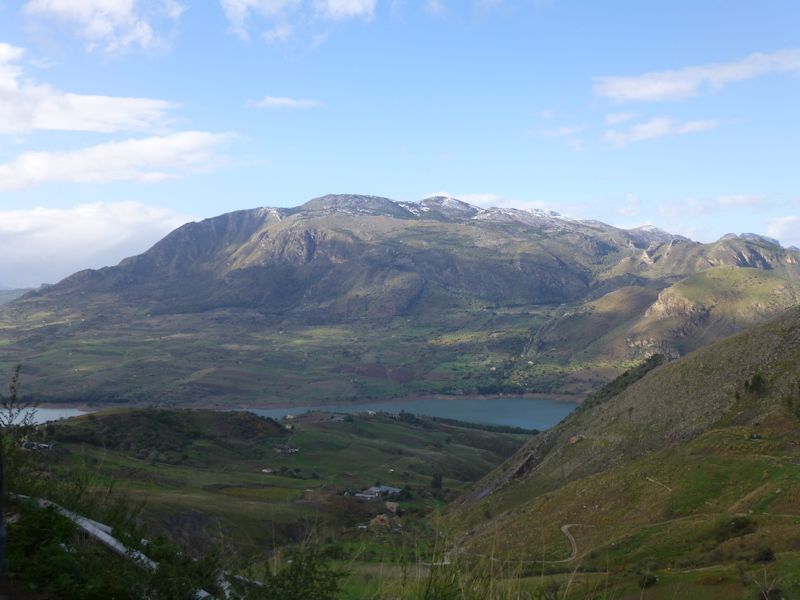
Now back down to the autostrada and eastward 20km or so to Cefalù.

And this is Cefalù, a picturesque medieval town that was founded by the Race of Giants, once had a temple to Jupiter hand-built by Hercules, and has still got (according to the tourist brochure) the Naiad Daphne imprisoned in the rocks above the town. That's all legend, of course: we're all aware that, as Ovid explains, Daphne got transformed into a laurel tree (Bernini's Apollo and Daphne in the Borghese is my favorite sculpture of all time).

And this is the Villa Cerniglia on the Lungomare road along the seashore, which we found entirely by accident and don't regret it at all (not a lot of accommodation was open in the dead of winter).
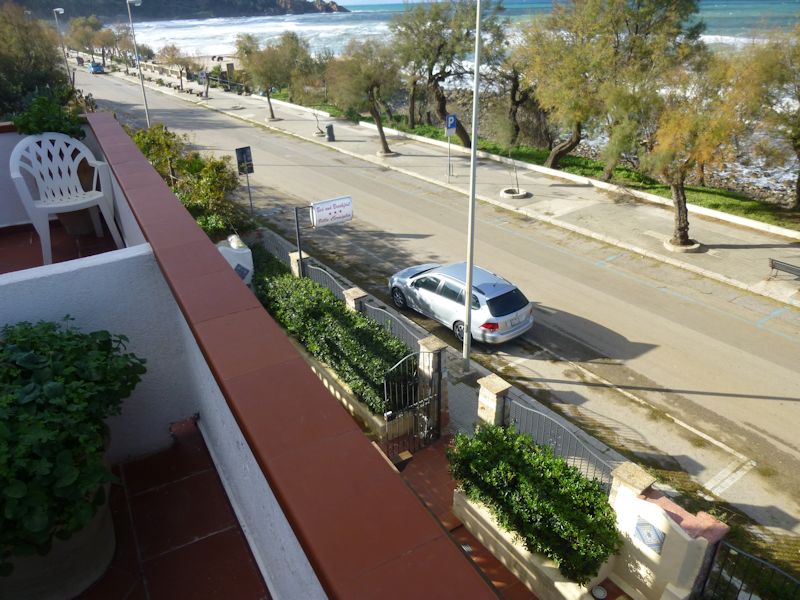
Fritz the VW looks lonely, but if this were summer he'd have lots of friends -- Cefalù is one of the most popular beach resorts for Italians and indeed for Europeans generally, and this must look like Seaside Heights, N.J., at the peak season (but without the Wild Mouse).

The town was founded in the 5th century B.C., probably as a Greek fortress up on the headland La Rocca (kephalé is the Greek word for 'head'); in any case, the remains of a temple of Diana from the 5th century B.C. can be visited just above the cliffs on the left side of the headland. Thereafter, the town was kicked around by Greeks and Carthaginians for a while and then destroyed by the Romans in 254 B.C. in their conquest of Sicily.
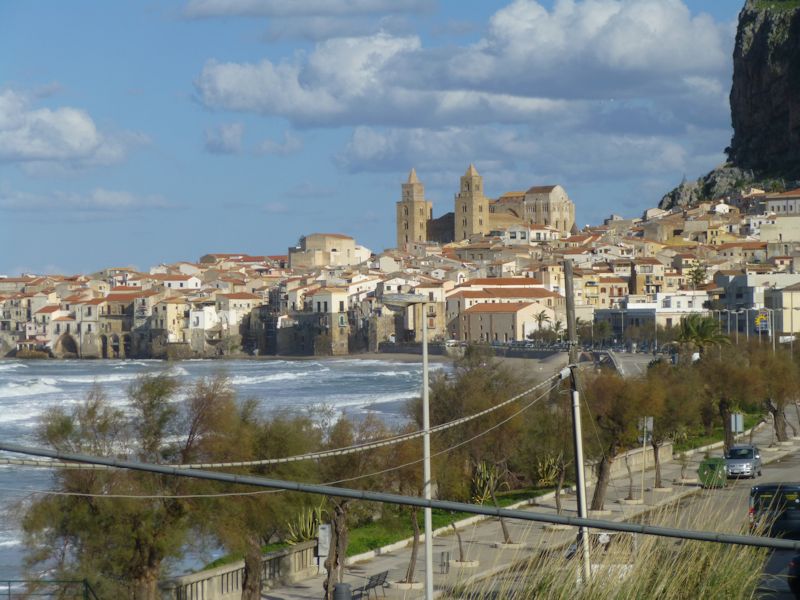
The view from our balcony. The Saracens captured Cefalù after a long siege in 858 and as part of the Emirate of Sicily it remained perched for security up on The Rock, until in 1063 the Normans took over and Roger II, in 1131, began building his cathedral and attracting more development down off the rock around the convenient little port.

La Rocca, with remains of the ancient Saracen city walls around the tops of the cliffs and the Temple of Diana up there somewhere.

The beach and parts of the small port on this side of the promontory.
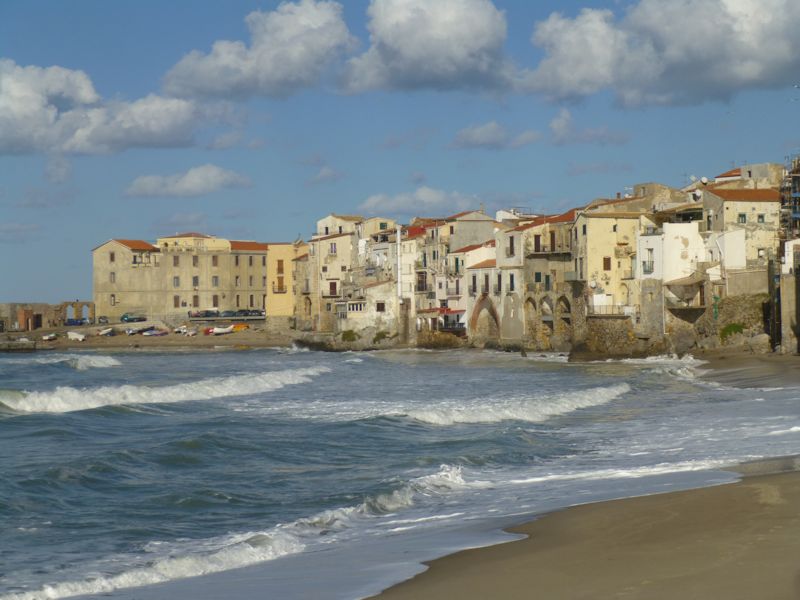
There is evidently a lively artisanal fishing activity here, though we didn't see it; we're out for a walk round town.

The Via Vittorio Emanuele one block in from the sea
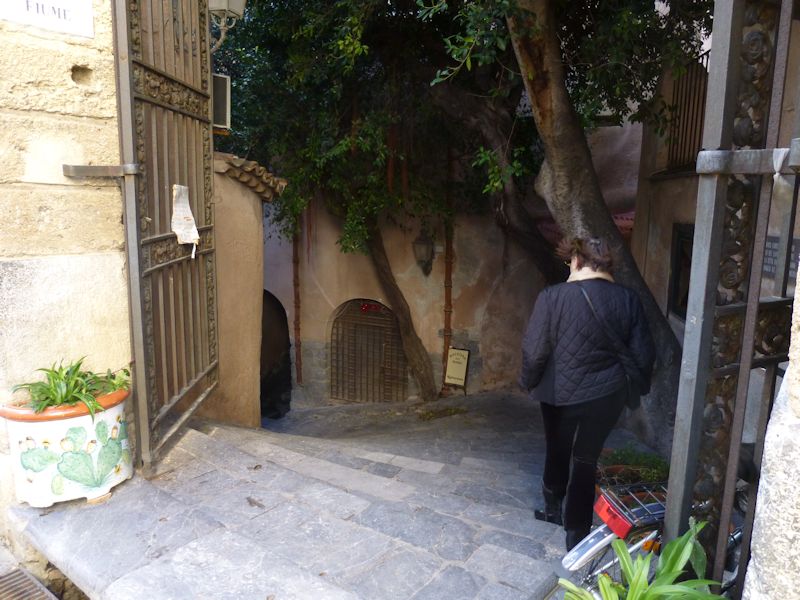
Just off the street and down the steps is the Lavatoio Medievale, the laundry place in the Arab-Norman period, where the moms could come and wash the clothes where the freshwater underground river Cefalino comes out into the sea.
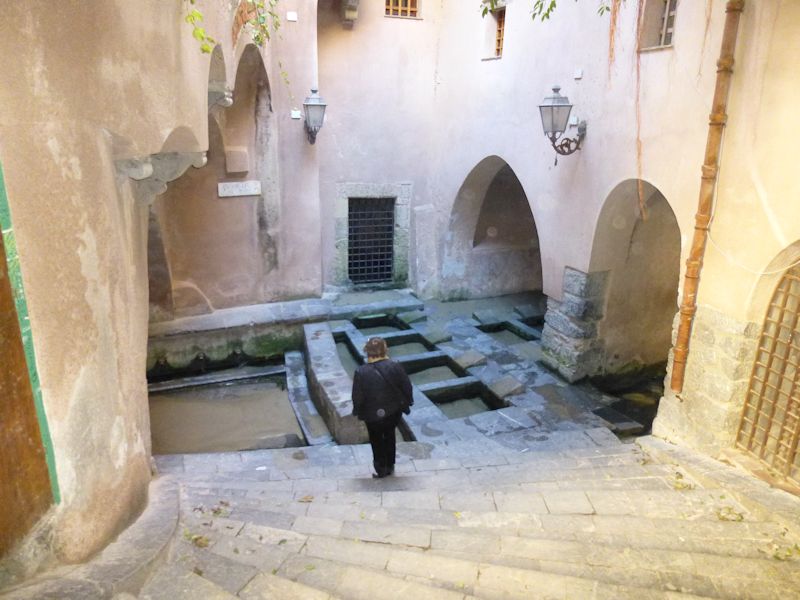
Washing basins built into the structure

The Pirates' Cove restaurant -- we had the place to ourselves, but it was excellent nonetheless.
(Kristin tolerates photographers.)

A squint at the Duomo up one of the side streets
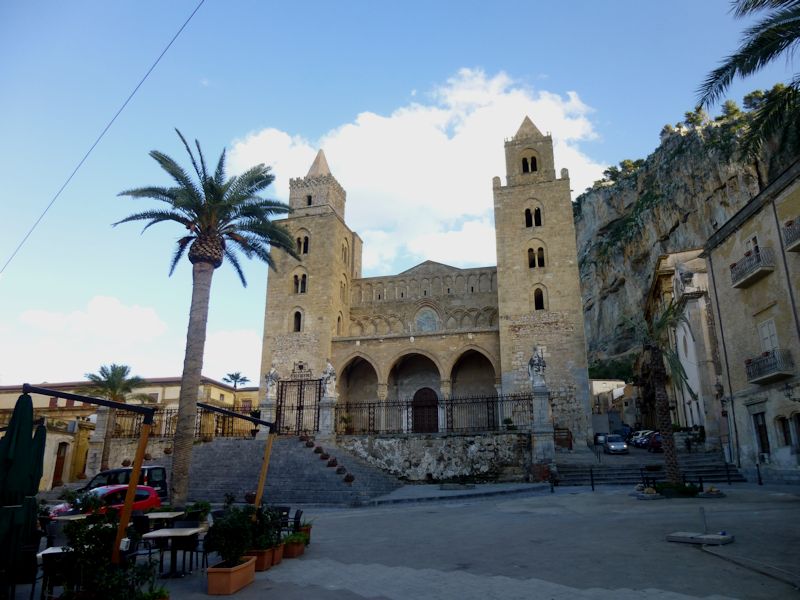
The Duomo di Cefalù, said to be rivaled only by Monreale and the Cappella Palatina in Palermo -- Roger II started it in 1131 evidently to create a rival ecclesiastical seat to Archbishop Walter's Duomo in Palermo in order to show Walter, the Pope, and the people that the Papacy's not having everything its own way.
(It's time for the Secular Arm to put its foot down!)
Unsurprisingly, the cathedral is closed, and we'll have to wait until the priest has finished his lunch and siesta.

The small port

Brisk seas at the seawall
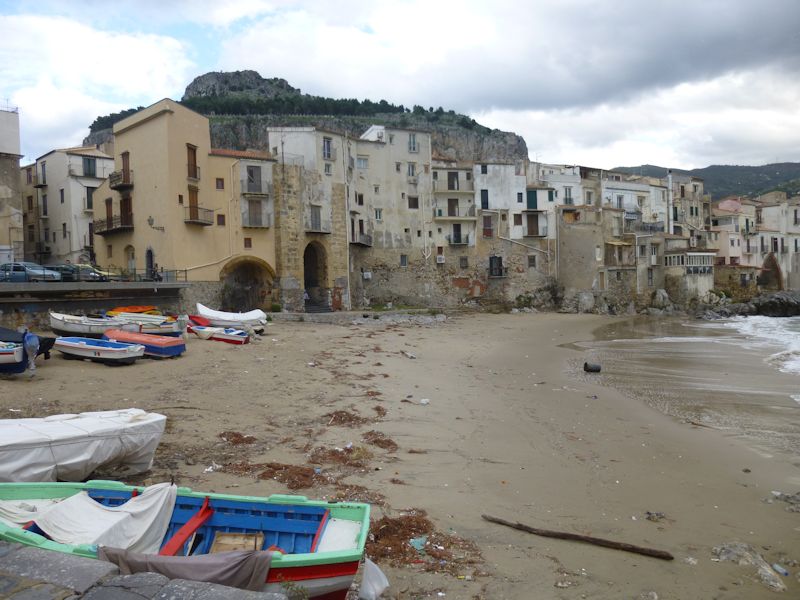
From the port's seawall

We've just had lunch in that little place, to keep the wolves of Famine at bay for a little while longer.

Kristin at the seawall (I'm thinking, The French Lieutenant's Woman)

Cefalù. In summer, the town of ca.14,000 inhabitants swells to three times its size, and everyone parties till dawn.

Cefalù port and La Rocca

Street scene in the lower town

Kristin is checking out the Bastione Capo Marchiafava, a 17th century artillery platform intended to keep the evildoers at a respectful distance.

Casanova slept here. And had breakfast here.
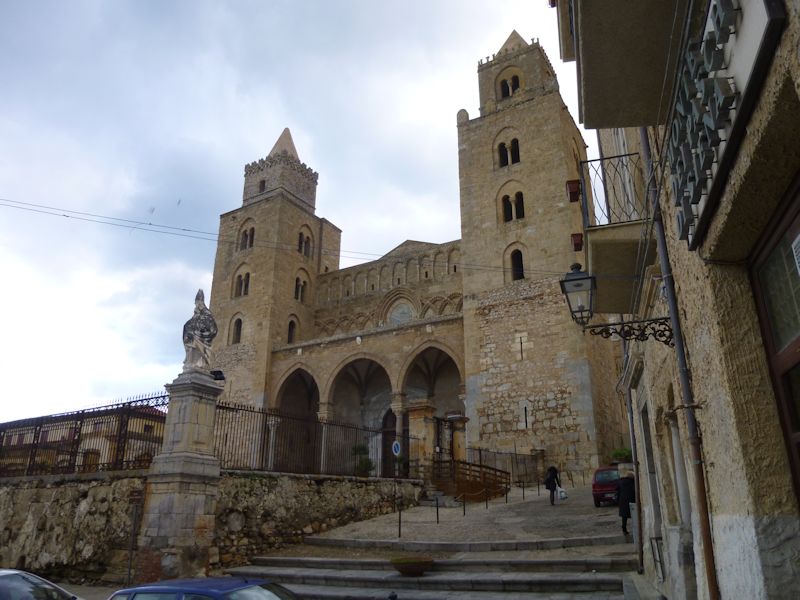
We're back, but the priest is not. This time, we'll sit here until someone takes pity on us.

We're in! But there's not much to see. There's Christ Pantocrator up there somewhere, amidst amazing Byzantine mosaics that antedate those at Monreale by a generation.
However, there is a problem. The renovators are here, and 1) we can't get close and 2) they're kicking up a binful of dust everywhere.

And to make that still more irritating or amusing, as you wish, moments later the portly old architect or project manager or whatever he was dashed out and began howling at the workmen for some gross malfeasance. Funny in its own way.

When we left a quarter of an hour later, he was still apoplectic and they were still sheepish.

A nice old font
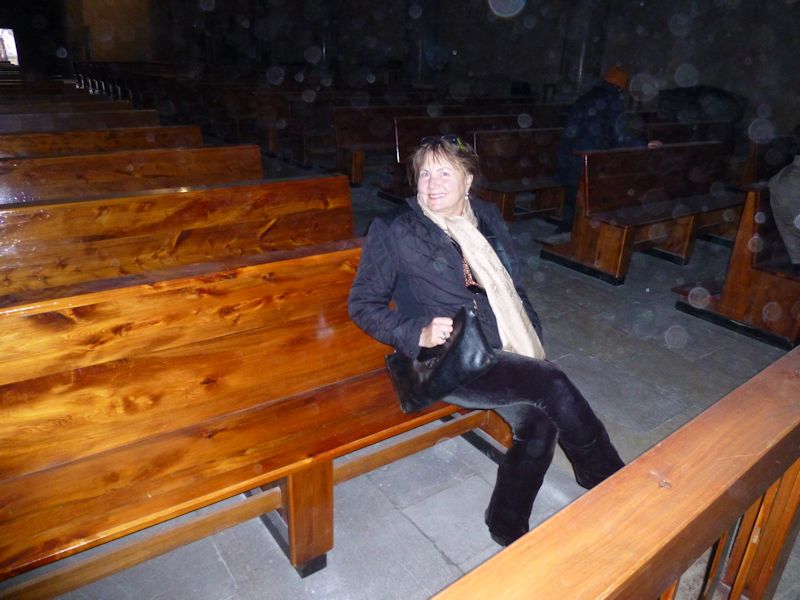
Kristin, settled in to enjoy the Battle Royale with the portly architect bouncing back and forth and shouting imprecations (because she can understand them and I can't).

The Pantocrator (the text says "He who follows me shall not walk in darkness" -- but He'd better not spend too much time breathing in this dust)

Ah. Air.

Forlorn people guarding the premises
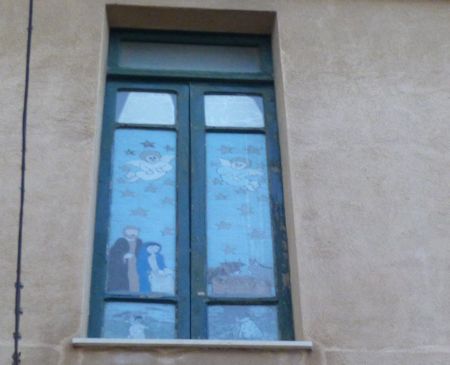 |
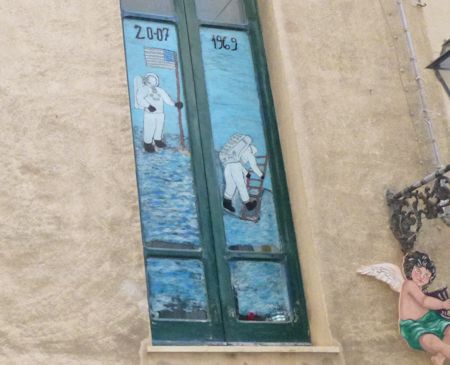 |
| The Christ Child comes to save mankind |
The Americans come to save the moon |
Cefalù kids celebrating milestones

The "Shopping Centre" (jewelry, mostly)

The main street above the port, the Corso Ruggero -- the evocative setting for Giuseppe Tornatore's Cinema Paradiso (1988), starring Philippe Noiret.
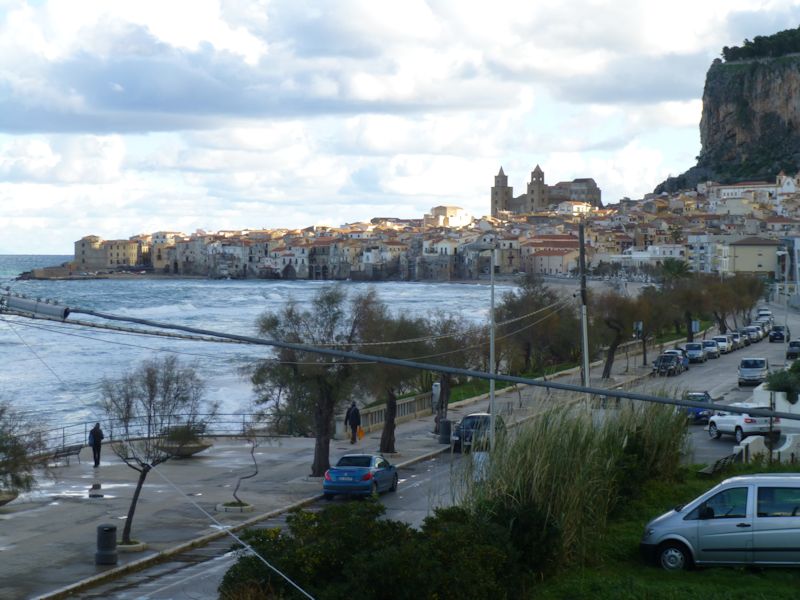
A not-too-much-past-dawn view of Cefalù as we pull out for Agrigento on the south coast, with a stopover at Enna on the way.


 Feedback
and suggestions are welcome if positive, resented if negative, Feedback
and suggestions are welcome if positive, resented if negative,  .
All rights reserved, all wrongs avenged. Posted 20 January 2013. .
All rights reserved, all wrongs avenged. Posted 20 January 2013.
|
 Dwight Peck's personal website
Dwight Peck's personal website












































